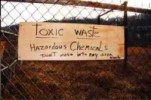Demanding a “full, proper and time-critical cleanup” of the CTS site in south Asheville, local residents have collected about 3,100 petition signatures, recently delivered in a 5-pound package to North Carolina Gov. Beverly Perdue and the state’s Division of Waste Management.
The immediate issue involves a proposed voluntary-cleanup agreement between the state and CTS, which once operated an electroplating plant on Mills Gap Road. The agreement sets a $3 million cap on the company’s cleanup of trichloroethylene and other toxins found at the site and in local groundwater supplies. Residents argue that a 2002 order from the U.S. Environmental Protection Agency overrides any such agreement because the site was declared an imminent hazard, still poses a health threat, and has seen little in the way of substantive cleanup.
The petition declares: “We, the undersigned, demand immediate action from the U.S. EPA on the preceding Formal Order of Enforcement of 2002. Enforcement of this Federal Order precedes and supersedes any state or county agreement with CTS. There should be no cleanup cost limitation awarded, at any future tax-payer expense, to the parties responsible for the contamination and the endangerment from a delayed clean-up resulting in both loss of health/life and property values.”
The petition package also contains a letter to Gov. Perdue, requesting that she deny approval of the voluntary remediation agreement. “In its place, we petition you to order an immediate mandatory cleanup of the site as provided by law,” writes Glen Horecky, president of the Community Advisory Group appointed by Buncombe County Commissioners.
Hope Taylor, executive director for Clean Water for North Carolina, adds in a statement included with the petition, “A $3 million cap might have been considered reasonable in 1987 for a site if it were not considered to be an ‘imminent hazard,’ but such a limit could make a full clean-up impossible in 2009 under quite different circumstances.”
Residents also included copies of supporting resolutions and letters adopted by the Asheville City Council and Bunombe commissioners, along with U.S. Sen. Richard Burr’s request for an investigation into the EPA’s handling of the site in the past 20 years.
Petitioners point out that the CTS site lies immediately east and up-gradient from the city boundary in south Asheville and encompasses the headwaters of Dingle Creek and Robinson Creek, which both flow into the French Broad River.
To view the petition, letters, and resolutions, go to Xpress Files and click here.
— Margaret Williams



